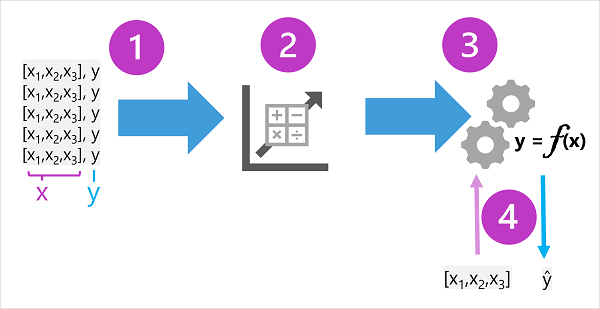Table of contents
Machine learning has its origins in statistics and mathematical modeling of data. The fundamental idea of machine learning is to use data from past observations to predict unknown outcomes or values.
Because machine learning is based on mathematics and statistics, it's common to think about machine learning models in mathematical terms. Fundamentally, a machine learning model is a software application that encapsulates a function to calculate an output value based on one or more input values. The process of defining that function is known as training.
After the function has been defined, you can use it to predict new values in a process called inferencing.
In mathematical terms, you'll often see the features referred to using the shorthand variable name x, and the label referred to as y. Usually, an observation consists of multiple feature values, so x is actually a vector (an array with multiple values), like this: [x1,x2,x3,...].
Let's explore the steps involved in training and inferencing.

1)
features (x) —>*Whether* measurements for the day (temperature, rainfall, windspeed, and so on)
label (y) —> number of ice creams sold on each day
In the ice cream sales scenario, our goal is to train a model that can predict the number of ice cream sales based on the weather. The weather measurements for the day (temperature, rainfall, windspeed, and so on) would be the features (x), and the number of ice creams sold on each day would be the label (y).
2) An algorithm is applied to the data to try to determine a relationship between the features and the label, and generalize that relationship as a calculation that can be performed on x to calculate y.
The specific algorithm used depends on the kind of predictive problem you're trying to solve (more about this later), but the basic principle is to try to fit a function to the data, in which the values of the features can be used to calculate the label.
3) The result of the algorithm is a model that encapsulates the calculation derived by the algorithm as a function - let's call it f. In mathematical notation:
- y = f(x)
4) Now that the training phase is complete, the trained model can be used for inferencing. The model is essentially a software program that encapsulates the function produced by the training process. You can input a set of feature values, and receive as an output a prediction of the corresponding label.
A breakdown of common types of machine learning is shown in the following diagram

Supervised machine learning is a general term for machine learning algorithms in which the training data includes both feature values and known label values
—> Regression is a form of supervised machine learning in which the label predicted by the model is a numeric value. For example:
The number of ice creams sold on a given day, based on the temperature, rainfall, and windspeed.
The selling price of a property based on its size in square feet, the number of bedrooms it contains, and socio-economic metrics for its location.
Classification
Classification is a form of supervised machine learning in which the label represents a categorization, or class.
Binary classification
In binary classification, the label determines whether the observed item is (or isn't) an instance of a specific class. Or put another way, binary classification models predict one of two mutually exclusive outcomes. For example:
Whether a patient is at risk for diabetes based on clinical metrics like weight, age, blood glucose level, and so on.
Whether a bank customer will default on a loan based on income, credit history, age, and other factors.
Whether a mailing list customer will respond positively to a marketing offer based on demographic attributes and past purchases.
Multiclass classification
Multiclass classification extends binary classification to predict a label that represents one of multiple possible classes. For example,
The species of a penguin (Adelie, Gentoo, or Chinstrap) based on its physical measurements.
The genre of a movie (comedy, horror, romance, adventure, or science fiction) based on its cast, director, and budget.
In most scenarios that involve a known set of multiple classes, multiclass classification is used to predict mutually exclusive labels. For example, a penguin can't be both a Gentoo and an Adelie
Unsupervised machine learning
Unsupervised machine learning involves training models using data that consists only of feature values without any known labels. Unsupervised machine learning algorithms determine relationships between the features of the observations in the training data
Clustering
The most common form of unsupervised machine learning is clustering. A clustering algorithm identifies similarities between observations based on their features, and groups them into discrete clusters. For example:
Group similar flowers based on their size, number of leaves, and number of petals.
Identify groups of similar customers based on demographic attributes and purchasing behavior.
How is clustering similar to and different from multiclass classification?
- In that it categorizes observations into discrete groups. The difference is that when using classification, you already know the classes to which the observations in the training data belong; so the algorithm works by determining the relationship between the features and the known classification label. In clustering, there's no previously known cluster label and the algorithm groups the data observations based purely on similarity of features.
- For example, you might use clustering to segment your customers into groups, and then analyze those groups to identify and categorize different classes of customer (high value - low volume, frequent small purchaser, and so on). You could then use your categorizations to label the observations in your clustering results and use the labeled data to train a classification model that predicts to which customer category a new customer might belong.